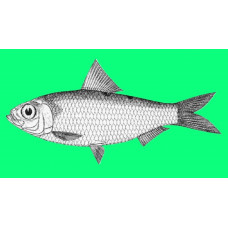Latin name
Herklotsichthys dispilonotus
Other name
Herklotsichthys dispilonotus
Identification
Overlaps the range of H. quadrimaculatus, which lacks the black saddles and has elongate wing like scales below the usual paired pre-dorsal scales.
Features of fish fins
Dorsal spines (total): 0; Dorsal soft rays (total): 13-21; Anal spines: 0; Anal soft rays: 12-23.
Fish colouring
They are immediately distinguished from all other species of Herklotsichthys by the presence of two dark saddle-shaped spots on the back, behind the base of the dorsal fin and a short distance behind it.
Distribution
West Central Pacific: Gulf of Thailand, Philippines and Indonesia.
Habitat
Marine tropical brackish pelagic-neritic species. Depth range 0 to 50 m.
Size
Maximum length 8.5 cm.
Behavior
An unusually gregarious coastal species.
Food and feeding habits
Nothing is known about the diet of Blacksaddle herring.
Reproduction
Oviparous.
Fishing
Traditional methods such as rod and reel, arrows and harpoons, abandoned nets and small traditional fishing boats are used to catch this species.
Relationship with a person
Harmless.
| Classification | |
| Phylum | Chordata |
| Class | Actinopterygii |
| Squad | Clupeiformes |
| Family | Dorosomatidae |
| Genus | Herklotsichthys |
| Species | H. dispilonotus |
| Features | |
| Conservation status | Least Concern |
| Habitat | Pelagic |
| Life span, years | No information |
| Maximum body weight, kg | No information |
| Maximum length, cm | 8,5 |
| Sailing speed, m/s | No information |
| Threat to people | Edible |
| Way of eating | Predator |
Blacksaddle herring
Tags: blacksaddle herring

